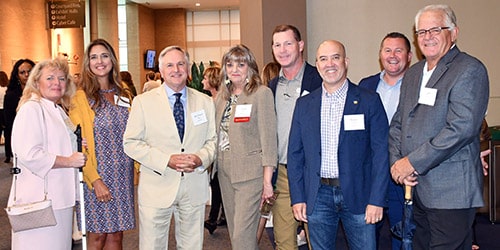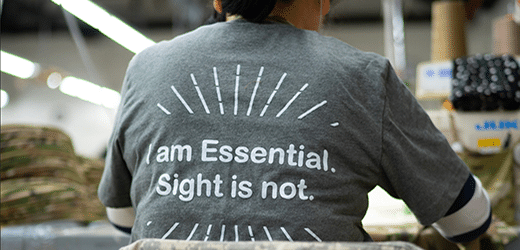Mission Moment: Meet the Real Superman

Most people are familiar with the origin story of Superman. He was born on the planet Krypton and his parents built a spaceship for their son after learning of Krypton’s imminent destruction. The spacecraft landed on Earth in the rural United States. Superman was raised as Clark Kent and he committed himself to using his superpowers to help others and fight crime. In some iterations of Superman’s story, he grew up in a fictional Kansas town called Smallville.
This isn’t the story about that Superman. It’s the story of the real Superman who grew up in a small Kansas town.
Romia Hall, Jr. was raised in Bonner Springs, Kan. He was an elite track and field sprinter in high school with career bests of 10.6 in the 100-meter dash and 22.20 in the 200 meters – times that would rank among the best in the nation at the high school level in any given year. He was the anchor of the 4×100 meter relay team that broke the school record.
But, his blazing speed isn’t why Hall is Superman. Much like the fictional Superman, Hall’s ascension to becoming a superhero was born out of tragedy.
In 2014, at the age of 30, Hall was the victim of a vicious altercation. He was stabbed in his eye and in his back twice. Just like that, his vision was gone.
“The knife went through my left eye and cut the optic nerve in my right eye and also punctured by brain,” Hall said. “When I was stabbed in the back, one of the wounds was less than a half inch from my spinal cord. It was a miracle that I’m able to even walk.
“When I was recovering in the ICU,” Hall said, “my oldest son called me. He said, ‘Daddy, I’ve got something to tell you. You survived getting stabbed. You’re Superman.’ At the time, it made me cry. But, I’ve been going with the idea of Superman ever since.”
The real Superman didn’t become an inspiration to scores of people overnight. First, Hall needed to get his life back.
“It was very, very hard,” Hall said. “In the beginning, I really needed to fix my mental state of mind.”
In 2015, he spent six months in Alphapointe’s rehabilitation program. He re-learned how to do all the things he’d always done – just differently due to no longer having sight.
“Going through the program gave me a sense of independence,” Hall said. “After I lost my eyesight, I was scared to go outside and walk around because you think you’ll bump into everything. One of the most important things to me was learning how to read Braille. I had always read to my kids, but I had stopped. After going through the program, I could read to them again and that meant so much to me. Without Alphapointe, I would be stuck inside the house and losing my mind. Alphapointe gives people the tools to enjoy living again.”
After Hall completed the program at Alphapointe, he wasn’t sure what was next. Gradually, he realized that he needed to take the next step and get back to work.
“After I finished the training at Alphapointe, I was living off the government through the disability program,” Hall said. “I didn’t like that. I wanted to make my own money and support myself. So, I called Alphapointe and put in a job application. I started as an assembler and worked my way up pretty quickly. After six months, I started running the CAP machine. I actually think it’s helpful to have someone who doesn’t have their eyesight running the machine because I rely on my hearing to know if something’s wrong, which means I hear it before somebody sees it. It’s kind of funny – whenever we have new people come on board, they always think I can see.”
Part of Hall’s rehabilitation process was returning to something he loved as a child: running. With encouragement from his orientation and mobility instructor at Alphapointe, Hall returned to the track. Only, this time, he traded in his sprinter spikes for a pair of distance shoes.
“I tried sprinting at first,” Hall said. “But, you realize pretty fast that if you’re running at top speed, it’s scary. The first thing that goes through your mind is that if you hit something, you’re done. So, it wasn’t a hard choice to switch to distance running.”
With encouragement from his nurse practitioner, Ashley, Hall decided to participate in his first race: the annual Children’s Center for the Visually Impaired Trolley Run in Kansas City. With Ashley by his side, he finished the 4-mile race in just over an hour while wearing a Superman shirt. Hall enjoyed it so much that six months later he made the big jump to running in the Kansas City Half-Marathon where, despite injuring his knee during the first half of the race, he finished in just over 3.5 hours. Since those first two races, he’s competed in several more – all while wearing a Superman shirt – with no plans to stop. He told his children that he will finish enough half-marathons so that each of them can have a medal from a race. Then, he plans to run a full marathon and keep that medal for himself.
For those who aren’t avid runners, they often pose the same question to those who are: why do you do it?
In Hall’s case, it’s not just for him.
“I run these races because I get motivation from knowing that it inspires other people,” Hall said. “It shows that people without eyesight can still do these types of things. Since I lost my sight, a lot of people have tried to tell me that I can’t do things. People are always surprised by the things I do. A disability is a not a body set. It’s a mindset. No matter what your body is going through, if your mind is right, you can do anything. That said, all the praise is to God because I’m only here today and where I am right now because of him and I cannot do anything without my Lord and Savior Jesus Christ.
“People often use the saying ‘the sky is the limit,’” he said. “That doesn’t work for me because when I look up, I don’t see a sky. So, there’s no limit to what I can accomplish.”
Inspirational words from the real Superman.





